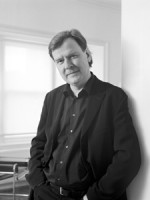Title
Dedicated to the performance of contemporary classics, Juilliard’s newest new music ensemble, Axiom, will begin its season with a pair of concerts devoted to exploring the music of Magnus Lindberg and the composers who influenced him. Now in its sixth season, the ensemble, which features flexible instrumentation and a flair for the eclectic, has given dozens of performances of the staples and hidden gems of 20th- and 21st-century repertoire. Music director Jeffrey Milarsky is excited about the new season, which, in addition to showcasing the music of current New York Philharmonic composer-in-residence Lindberg, will mark important birthdays for Steve Reich and Pierre Boulez. The season will also see the continuation of a strong relationship between the ensemble and downtown performance venue Le Poisson Rouge.
Body
The centerpiece of Axiom’s season opening concert on October 11 is the Juilliard premiere of Lindberg’s work Joy(1990), the last of a triptych of works for orchestra that also includes Kinetics (1988) and Marea (1989). The work, Milarsky noted in a recent interview, represents an important milestone in Lindberg’s creative career, falling stylistically between the hyper-complexity of his earlier works and the quasi-Neo-Classical period which has emerged in more recent years. “Joy is a very important piece,” Milarsky said. “He’s rethinking his style. It’s a real development and departure for him.” Milarsky also praised Lindberg for his ingenuity and economy. “Even though it’s a sinfonietta-sized group, he makes it sound like a full orchestra.”
The other large ensemble work on the program is Igor Stravinsky’s Symphonies of Wind Instruments (1920). This rarely performed piece is not a symphony in the traditional sense; rather, Stravinsky uses the term in its purely Greek sense to denote the “sounding together” of the instruments in the ensemble. Symphonies was written in memory of Claude Debussy (1862-1918), a composer whose gentle and shimmering sound world sometimes causes one to forget the underlying structural innovations.
“It’s dedicated to Debussy and it’s a very important dedication,” said Milarsky, “because it has to do not only with [Stravinsky’s] friendship, but with who Debussy was as a composer and also how avant-garde and weird Debussy was at the time. He stood out all by himself.” This work honors its dedicatee in several ways, both in its rejection of Romantic idioms and nods to the Eastern music which so fascinated Debussy. “There’s something about this piece—an austerity, [a] non-personal approach to music. It’s very modern. It has three different tempi, which occur in panels. They’re not prepared; they have careful interrelationships, of course, but they’re juxtaposed very quickly. That’s a very avant-garde thing.”
Milarsky has opted to use the original version of the score, rather than the 1947 rewrite. “I think it’s got a more acidic quality to it,” he said. “Even with Rite and Petrushka, I like the early versions because I think they have a little bit [more] of a raw quality than the [later] ones. An older composer might round the edges out.” Keeping track of Stravinsky’s multiple revisions of many of his most famous scores has plagued orchestra librarians for decades. Sometimes his choices were practical, in the case of reducing the orchestration for The Rite of Spring; in many other cases, he would prepare “revised” versions to settle copyright disputes in a world before ASCAP.
The final work on the program comes from the pen of Greek architect-cum-composer Iannis Xenakis, noted for his tectonic distribution of sound masses through time, and whose music Lindberg studied intensely. Okho (1989) is scored for three djembes, a type of West African hand-drum characterized by rich sound quality and a variety of tonal possibilities. Though the number of players required for this piece is small, Milarsky hopes the effect is big. “The root of all music is rhythm and I think Xenakis takes it to such a complex level that it’s actually kind of perfect on a sinfonietta concert,” he said. “It shows the most basic form and also the most advanced form. That’s Xenakis in a nutshell.”
If the program seems eclectic, it is due to that exact quality in Lindberg’s work. “Nobody knows more music than Magnus,” Milarsky said. “I like to think of [this program] as ‘Magnus’s World.’ He’s one of the most important musicians living today, and I want the students to get a lot out of him while he’s here.” As was the case last season, Lindberg will be on hand to coach Axiom during the rehearsal process. “I do these concerts that are conceptual but also ask, ‘What’s a really interesting listening experience?’ There’s a lot of differences between these works, but a lot of not-so-hidden similarities.”





